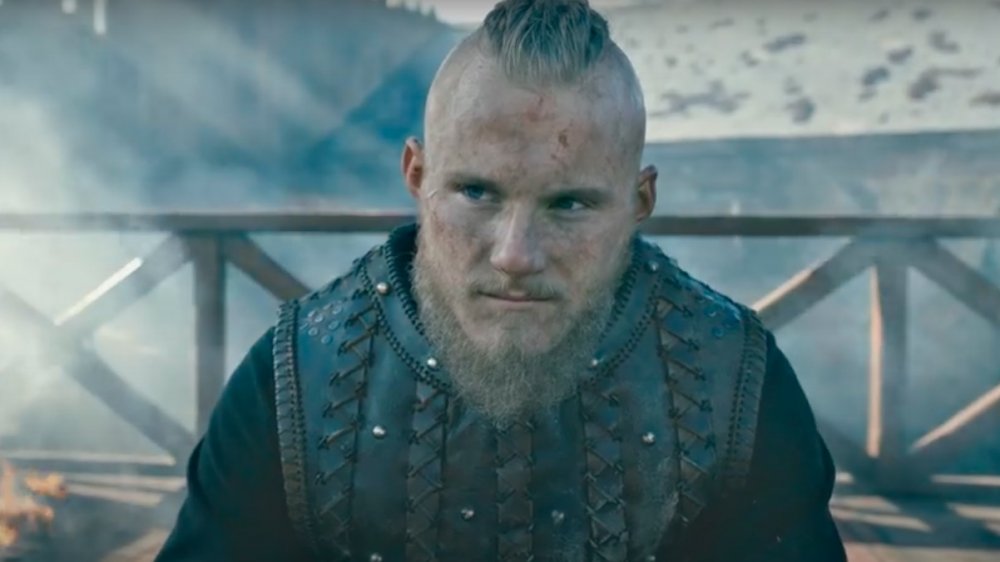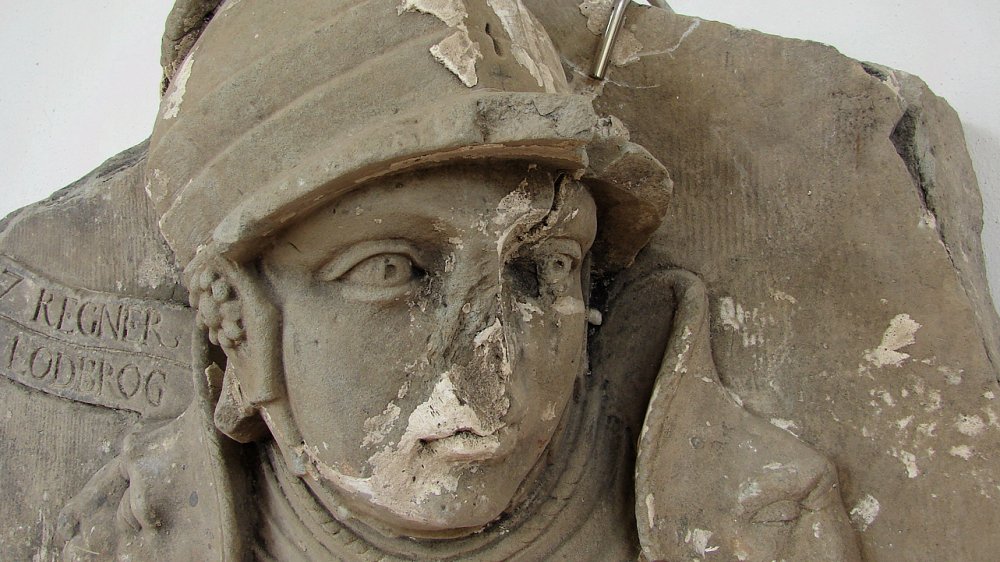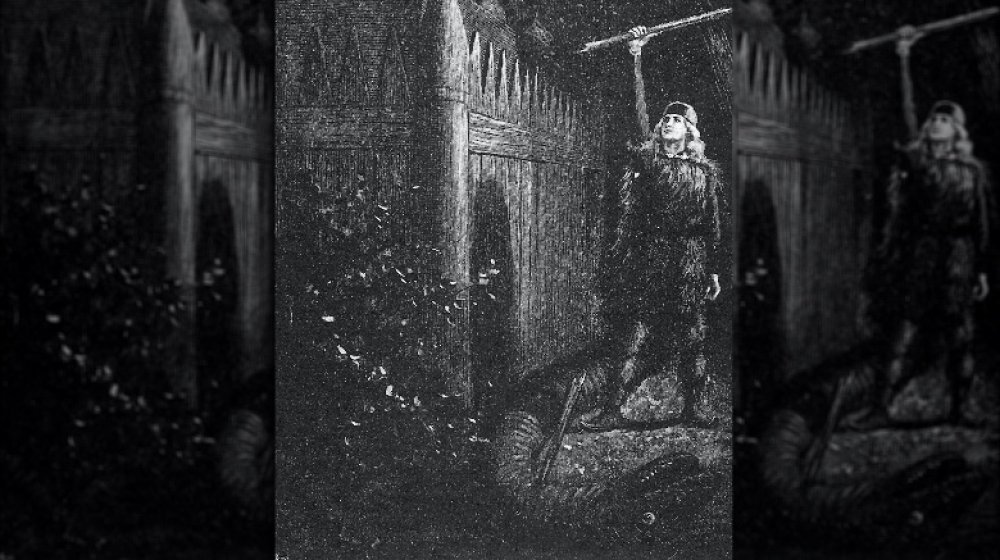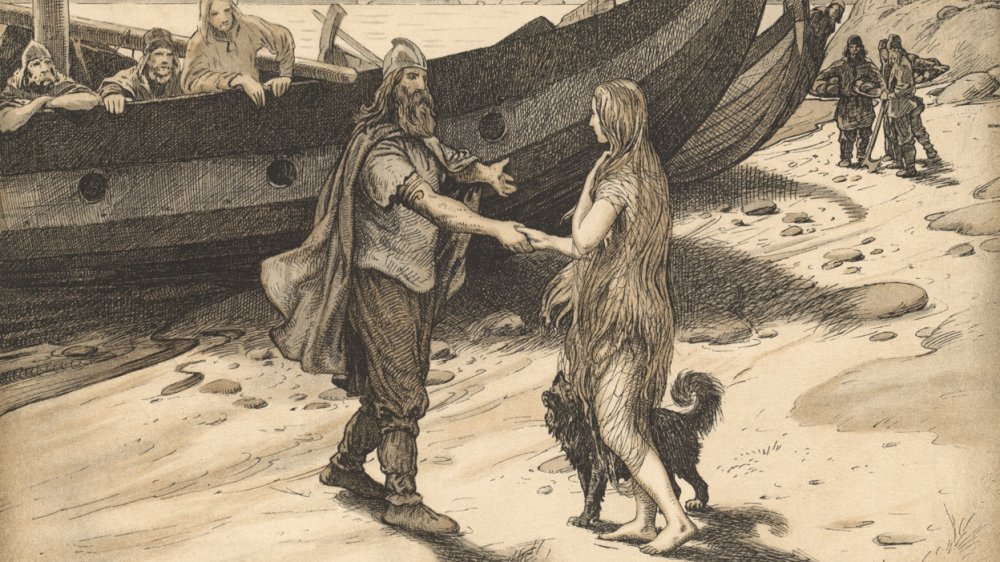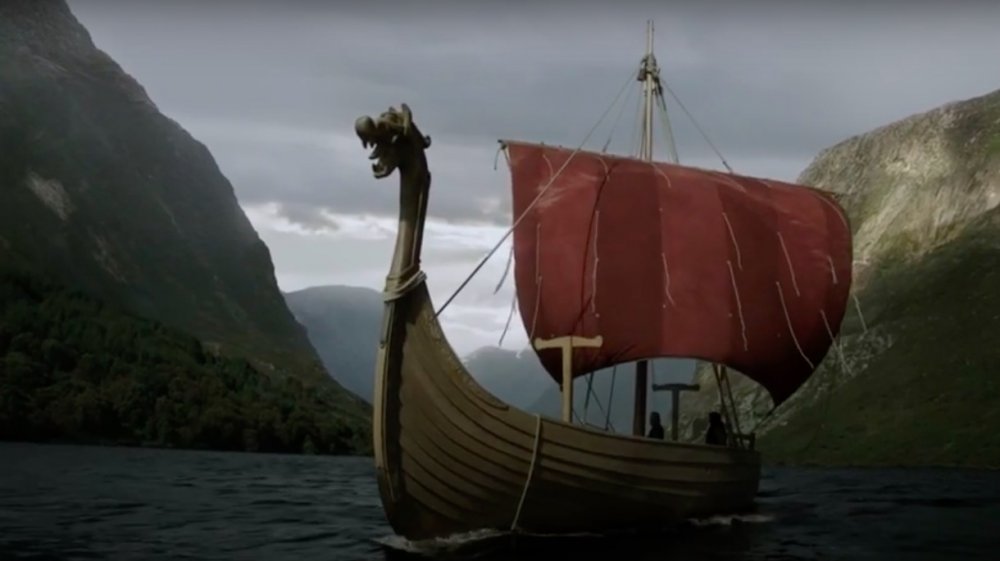The Untold Truth Of Ragnar Lodbrok
If you're a fan of the History Channel series Vikings, you know him as the extra super testosteronish sweaty bloodstained sexy manly man Ragnar Lothbrok, played by Travis Fimmel. And you may have taken it on faith that for all the Viking series' flaws (you know, like the biker costumes and probably the blood eagle thing), at least the protagonist was based on a real dude.
Well, maybe not. Maybe. Which means that it's especially difficult to tell the "untold truth" of Ragnar Lodbrok (that's the spelling most historians use) because when it comes to this charismatic figure from the Icelandic sagas there may not be anything that's exactly truthful, right down to his very existence. What we can do is tell you the untold truth of how the legends portrayed him, which is in itself quite different from the way the History Channel tells the tale of Ragnar. So put on your horned helmet (actually, Vikings didn't wear horned helmets, but do whatever makes you feel Viking-y) and hang on, because here are some things you probably didn't know about the possibly-real-but-probably-not real Ragnar Lodbrok.
Ragnar Lodbrok might not have existed, but his sons did
Ragnar's story wasn't even written down until 350 years after his death, which is part of what makes some historians skeptical of his existence. According to the Ancient History Encyclopedia, most of the sources that mention Ragnar are old, and a lot of the information in those sources is conflicting. Another problem with the historical record is that there wasn't a lot of real history recorded during the 9th century, which is when Ragnar supposedly existed, and a lot of Vikings had pretty similar names, which makes it hard to tell the difference between Ragnar and some other guy whose name sounded kind of like "Ragnar."
Now, Ragnar Lodbrok supposedly had a bunch of sons, and historians are pretty sure that his sons existed. Ivar the Boneless — who was exactly as scary in real life as he is in the History Channel series — was a real person, though we don't know how much of his story is fiction and how much is fact. Bjorn Ironside probably existed, too, and so did Sigurd Snake-in-the-Eye. It's possible, though, that these "sons" only really claimed to be the offspring of the legendary Ragnar because being the offspring of Ragnar gave them a certain amount of street cred. They may not even have said they were Ragnar's sons at all — it's also possible that the authors of the legends assigned them to Ragnar's legacy because it made the stories seem tidier.
Ragnar's story was told far and wide
Ragnar appears in a number of different stories and he doesn't always have the same name, which means he may actually be a combination of different historic people. According to the Ancient History Encyclopedia, the best-known of these stories is The Saga of Ragnar Lothbrok, which is one of the famous Icelandic sagas written during the 13th century. He was also the star of an Old Norse skaldic poem called Ragnarsdrapa, which is loosely translated as "The Poem About Ragnar," and a 12th-century poem called Krakumal or "Words of the Crow." Various other Norse sources name him, too, and he even has a starring role in Latin texts such as Gesta Normannorum ducum ("Deeds of the Norman Dukes") and a couple of chronicles of Danish kings. The 9th century Frankish Annals of St. Bertin talks about a Viking chieftain named "Reginherus," who led an invasion on Paris in 845 — the name isn't exactly the same, but it's typically assumed that Reginherus and Ragnar are the same person.
So if Ragnar wasn't real, who was he based on? Well, there are a number of strong candidates, including the Danish king Horik I, who lived during the mid-9th century and was responsible for a bunch of raids against the Frankish king Louis the Pious. Other candidates include King Reginfrid of Denmark, who died in 814, and Reghnall, who starred in the Irish Annals.
Ragnar got his name from his pants
Imagine earning the nickname "Craig of the Cargo Shorts" or "Michael Mom-Jeans." That's cool and all if you happen to be living in the era where cargo shorts are a thing and mom jeans have made a mysterious comeback. But no good thing lasts forever, which is probably why most modern humans don't earn lasting legendary nicknames based on what they wear to parties. Ragnar, however, wore such an unusual pair of pants (on at least one occasion) that he ended up being saddled with the name "hairy breeches" forever and ever until well after his legendary death and well into the History Channel series.
According to Ancient Origins, Ragnar made himself a pair of armored pants from furry animal skin, but the fur wasn't the only strange thing about them. To harden them against his foe (in this case a very large snake), he boiled them in pitch, rolled them in sand, and then froze them so they'd be difficult for the snake to bite through. So it was a very uncomfortable battle especially for, you know, Ragnar Junior, but he came away victorious and the name stuck.
His parents died tragically
If Ragnar was a myth then his parents didn't die tragically (or at all) because myths don't have parents. If he wasn't a myth, well, some bad stuff happened in his childhood but hey, in the 9th century a lot of bad stuff happened in pretty much everyone's childhoods, so at least he was in good company. According to The Vikings: Philosophy and History from Ragnar Lodbrok to Norse Mythology, Ragnar was the son of King Sigurd Ring, who was a descendant of the Norse god Odin. Ragnar's mother was Alfild, who had an unfortunately short-lived role in the saga of Ragnar because she died when he was still a child. His mother's tragic death didn't exactly cause Ragnar and his father to become closer, though — Sigurd went off in search of a new bride and set his sights upon Princess Alfsol of Jutland.
Sigurd asked politely first, but Alfsol's parents were not interested in obtaining an aging Viking groom for their daughter, so Sigurd decided to win Alfsol the old fashioned way: by force. Alas, he was no match for her overprotective parents, who poisoned their daughter so that Sigurd couldn't get his hands on her. Nice. Anyway, instead of giving up and sailing back to his son, Sigurd jumped onto Alfsol's funeral pyre and stabbed himself, thus leaving Ragnar an orphan and a king at the tender age of 15.
Ragnar's first wife was a badass
Lagertha is, of course, the best thing about the History Channel's Vikings and if you don't agree then you need to go rewatch the whole series because you don't know anything. Anyway, Lagertha isn't in every one of Ragnar's stories — in fact according to the Ancient History Encyclopedia she only appears in the Latin Gesta Danorum, where she became Ragnar's love interest shortly after the Swedish King Fro killed Ragnar's grandfather King Siward of Norway and put all his female relatives in a brothel.
When Ragnar arrived in Norway to take revenge on Siward's murderer, he was met by a band of women who offered to join him in the fight against King Fro. One of those women was Lagertha, who the Gesta Danorum describes as "a skilled Amazon, who, though a maiden, had the courage of a man, and fought in front among the bravest with her hair loose over her shoulders." Ragnar was smitten but Lagertha was all, "I really need to keep this stalker out of my house" and got herself a couple of furry bodyguards. When Ragnar arrived at her home he found it guarded by a bear and a large dog, but being the hero he was he managed to slay both animals and claim Lagertha as his bride, seemingly indifferent to the part where Lagertha was totally not into him because, you know, BEAR and LARGE DOG, dude.
Ragnar left Lagertha for some mystery person he saw in a mirror
Lagertha eventually warmed to her new husband, probably because she didn't really have a choice, but alas, Ragnar's heart was fickle. After three years of marriage and as many children, Ragnar heard news that his kingdom had been attacked and went, "Hooray an excuse to leave Lagertha." He then basically abandoned her and headed back to his homeland where a seer showed him a magical image of a woman named Thora in a mirror.
According to the Ancient History Encyclopedia, the Gesta Danorum basically shrugs off the whole Lagertha/Ragnar relationship at that point, noting that in "changing his love and desiring Thora ... [Ragnar] divorced himself from [Lagertha]; for he thought ill of her trustworthiness, remembering that she had long ago set the most savage beasts to destroy him." Oh right. it was because he "remembered" all that stuff about the bear and the dog after three years of not caring about it and it had nothing at all to do with the lovely lady in the mirror. Gotcha.
Lagertha wasn't the sort of girl who let a little thing like spousal abandonment get her down, though. She remarried and when Ragnar came crawling back to her for help putting down unrest in his kingdom, she graciously offered him 120 ships, won a battle for him, then went home and murdered her new husband so she could rule in his place.
He had to kill a dragon in order to marry his second wife
Thora looked pretty good in the mirror but alas, there was a catch. Like Daenerys Targaryen before her, Thora was a mother of dragons, or possibly just one dragon or maybe just a really big snake, depending on which version of the story you're reading. Evidently, Thora had hatched the creature from a swan's egg and it had grown so large that it coiled around her house and wouldn't let anyone come close to her. Oh and also it breathed fire, spat venom, and produced noxious fumes.
Thora's father was understandably concerned about the giant snake(s) or dragon(s) or whatever and offered his daughter's hand in marriage plus a whole lotta gold to whatever was brave and strong enough to slay the beast(s). According to the Ancient History Encyclopedia Ragnar took the job (Lagertha who?), donned the hairy breeches he was named for, slayed the snake/snakes/dragon/dragons, and married Thora. This time Ragnar's love appeared to be genuine, because for all the years of their marriage he gave up going on raids and other Vikingy things so he could stay home with her and watch History Channel's Vikings on Netflix. Just kidding. Ragnar actually thought Travis Fimmel's performance was flat and that the biker costumes were stupid. Anyway, Thora and Ragnar had two sons, but she died young, and that's when Ragnar finally decided to go back to raiding and pillaging.
On to wife number three
Ragnar's grief was temporary. According to Norse Mythology: Mystery and Magic from the Northern Lands of the Vikings, Ragnar was off raiding when he became intrigued by the beauty of a peasant named Kraka, but you know, he was a king and she was a commoner and first he had to convince himself that she was worthy. So he sent for her but directed that she was to come "neither clothed nor unclothed, neither full nor hungry and not alone but without anyone accompanying her." So Kraka ate one onion, wrapped herself up Lady Godiva-style in her own hair (and also a fishing net), and brought a dog. Ragnar was impressed by her cleverness and married her, and then of course found out that she was actually not a peasant girl but the daughter of a legendary dragonslayer named Sigurd and a Valkyrie (one of Odin's handmaidens) named Brynhild, because of course she couldn't have actually been a commoner or that would have ripped a hole in the space-time continuum. Also her name wasn't Kraka, it was Aslaug, which evidently matters for some reason.
Aslaug and Ragnar went on to have a bunch of kids, including Ivar the Boneless who in the saga literally has no bones but manages to become a legendary warrior anyway. Incidentally, Ivar was cursed with bonelessness because his father was too eager on his parents' wedding night, so let that be a warning to you honeymooners.
Then he got cocky
After Ragnar's third marriage a whole bunch of weird stuff happened — the Swedish king got slighted because he was hoping Ragnar would leave his peasant wife for a real princess and it almost worked ... until Ragnar found out his wife actually had cool bloodlines and he snubbed the marriage offer. According to Norse Mythology: Mystery and Magic from the Northern Lands of the Vikings, the whole mess led to violence when two of Ragnar's sons tried to engage the Swedes but found themselves thwarted by a magical cow. Then Aslaug changed her name (again) and took her own sons into battle, thus winning the war.
So Ragnar should have been pleased at all of that but he wasn't. His own sons were kind of messing up his reputation by being mightier and winninger than he was, and Ragnar didn't like that one bit. So he boasted that he was going to invade England, and with only two ships, too, which would have been an impressive feat except for the part where he totally couldn't pull it off. Ragnar met the forces of King Aelle, failed to defeat them, and was captured.
Then Ragnar died, and then he died again, and a few more times after that
No, Ragnar wasn't a vampire or Natasha Lyonne in Russian Doll, but he did die a bunch of times in a bunch of different ways. To be fair, it seems to just be differences in the way each storyteller decided to end Ragnar's tale than an actual death loop. In the most famous version of Ragnar's death — the one that was retold by History Channel — Ragnar was captured by King Aelle and thrown into a pit of vipers. Or large non-venomous pythons if you were paying attention during that scene. That's where Ragnar utters his most famous line: "How the little piglets would grunt if they knew how the old boar suffers."
The snake pit version of Ragnar's death is easily the most epic, which is why it's repeated in multiple versions of his story. But according to Biography, that's not the only way Ragnar met his end — he also died from dysentery while leading a huge force against Paris, which although super un-glamorous also makes death by snake pit look like a stroll along the beach by comparison. But that wasn't the end of Ragnar. For years after his death by dysentery he turned up in places like Scotland and Ireland, where he eventually got tortured or just generically killed by his own countrymen. Later on, some rivals killed him, then he died in a raid before finally landing in Aelle's snake pit.
The revenge of Ragnar's sons
A common postmortem theme in Ragnar's stories is the way his grown sons reacted to his demise, which was to bring an army to the land where their father died and basically just kick the poop out of everything they saw. But there are variations on the events leading up to the arrival of the Great Heathen Army, too. One is the famous snake pit story, which happened after Ragnar tried to attack England with only two ships. In another version, though, Ragnar is innocent — according to Ancient Origins he was just out sailing around in a boat when he got caught up by a storm and became shipwrecked on the coast of East Anglia. Instead of getting thrown into a snake pit he was rescued and eventually became pals with Edmund, king of the East Angles. The two kind of had a bromance and spent a lot of time hunting together, which evidently annoyed Edmund's chief huntsman Bern. In fact, Bern was so annoyed that he challenged Ragnar to a secret hunting contest out in the woods and then stabbed him to death.
Anyway, one thing led to another and eventually Bern ended up back in Viking Land, where he told Ragnar's sons that it was actually King Edmund who killed their father, thus bringing the Great Heathen Army down upon them all. Oh, and then the Vikings killed Edmund and played football with his decapitated head. Vikings.
The invasion of the Great Heathen Army did actually happen
In some of the legends, Ragnar's eventual demise is connected to the invasion of the Great Heathen Army, which was an actual invasion that occurred in or around 865. Ragnar's sons did indeed grunt when they heard how the old boar suffered, and they vowed to avenge their dad just like any good Viking kid would. According to English Monarchs, they brought an enormous fleet of ships with them to East Anglia, captured and killed King Edmund, sacked the city of York and then captured King Aelle and executed him by blood eagle. Which you might find comfort in knowing was probably not an actual thing, since it involved skin removal and lung removal and all kinds of additional nasty details.
Unfortunately for Ragnar fans, though, the Ragnar legends themselves are the only sources that really call the 865 invasion an act of revenge. There do seem to have been some characters involved in those events who shared names with Ragnar's sons and there's an account of Aelle's death, too, though there's mercifully no mention of the blood eagle. So what was Ragnar's real part in all this, if any? We can all imagine, but only Odin knows for sure.

